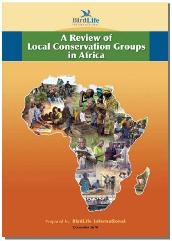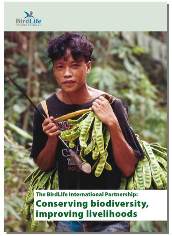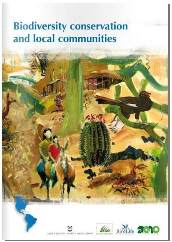|
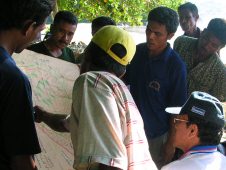
|
| © Burung Indonesia |
|
Conservation action is often best achieved by empowering local people. Since the late 1990s, BirdLife has been building a network of grassroots groups, known as Local Conservation Groups (LCGs), to harness local expertise and enthusiasm. Establishing effective community-based conservation is highly challenging—especially in regions of the world where local people lack secure land tenure and are marginalised from decision making. Despite this, the LCG approach has had significant success around the world in empowering civil society and reducing threats to biodiversity.
|
In large parts of the world, engaging local people in conservation offers the best hope of safeguarding biodiversity. Many of the root causes of biodiversity loss are local—local power structures, land owning patterns and inequities in the way costs and benefits are shared within and between communities. Likewise, many of the key decisions affecting resource management are made locally, and many of the changes needed to achieve conservation, relating for example to education and awareness, rules governing access to resources, and land-planning decisions, need to be delivered locally.
Whilst all of the world’s people rely to some extent on their local environment, it is often the rural poor whose livelihoods are most directly connected to their environment on a daily basis ( ,
,  ). Very often the place where they live is their source of food, fuel, medicine, shelter and income . Although many poor communities depend directly on natural resources, they are often forced to use these resources unsustainably in order to survive. Understanding how people experience poverty locally is essential in identifying how biodiversity conservation can help improve livelihoods (
). Very often the place where they live is their source of food, fuel, medicine, shelter and income . Although many poor communities depend directly on natural resources, they are often forced to use these resources unsustainably in order to survive. Understanding how people experience poverty locally is essential in identifying how biodiversity conservation can help improve livelihoods ( ).
).
Through a participatory process catalysed at the national level, the BirdLife Partnership has identified over 10,000 sites of highest priority for bird conservation ( ). Local empowerment is critical if these Important Bird Areas (IBAs) are to be safeguarded for the benefit of biodiversity and people. Consequently, BirdLife has pioneered Local Conservation Groups (LCGs; also known as Site Support Groups in Africa and Caretaker Groups in Europe) to support site-based action at IBAs. There are currently over 2000 such groups across the world. The structures, governance, membership and specific objectives of these groups vary greatly depending on the local context. This flexible approach can deliver tangible successes in a number of areas, from site conservation and monitoring to livelihood improvement and community empowerment:
). Local empowerment is critical if these Important Bird Areas (IBAs) are to be safeguarded for the benefit of biodiversity and people. Consequently, BirdLife has pioneered Local Conservation Groups (LCGs; also known as Site Support Groups in Africa and Caretaker Groups in Europe) to support site-based action at IBAs. There are currently over 2000 such groups across the world. The structures, governance, membership and specific objectives of these groups vary greatly depending on the local context. This flexible approach can deliver tangible successes in a number of areas, from site conservation and monitoring to livelihood improvement and community empowerment:
Conservation action
Community engagement and involvement in IBA conservation is vital. Since April 2006, BirdLife Cambodia has been working with local people to improve natural resource management at the Western Siem Pang IBA in North-east Cambodia. A network of LCGs has been established, comprising local stakeholders with a common interest in protecting the region’s unique wetlands (trapaengs). Local communities have agreed a Trapaeng Management Protocol, which prohibits damaging activities such as the use of poisons to catch fish, tree felling and large-scale water extraction ( ). In Bolivia, the creation of a LCG has helped reduce hunting and other damaging activities at Bajo Rio Beni IBA, home of the Endangered Wattled Curassow Crax globulosa (
). In Bolivia, the creation of a LCG has helped reduce hunting and other damaging activities at Bajo Rio Beni IBA, home of the Endangered Wattled Curassow Crax globulosa ( ). Around the world, volunteers underpin a huge amount of the work undertaken by the BirdLife Partnership (
). Around the world, volunteers underpin a huge amount of the work undertaken by the BirdLife Partnership ( ). Along the Victorian coast of south-east Australia, numerous volunteer groups have been established bringing together a vast network of coastal residents, land managers and beach-goers to help protect Hooded Plover Thinornis rubricollis (
). Along the Victorian coast of south-east Australia, numerous volunteer groups have been established bringing together a vast network of coastal residents, land managers and beach-goers to help protect Hooded Plover Thinornis rubricollis ( ). Grassroots environmental movements can end up delivering significant conservation results. For example, thanks to a campaign begun by local fishing communities, one of the most important wintering sites for the highly imperilled Spoon-billed Sandpiper Eurynorhynchus pygmeus—Khok Kham, in the Inner Gulf of Thailand—is on its way to being legally protected as a Ramsar wetland of international importance (
). Grassroots environmental movements can end up delivering significant conservation results. For example, thanks to a campaign begun by local fishing communities, one of the most important wintering sites for the highly imperilled Spoon-billed Sandpiper Eurynorhynchus pygmeus—Khok Kham, in the Inner Gulf of Thailand—is on its way to being legally protected as a Ramsar wetland of international importance ( ).
).
Improving local livelihoods and reducing poverty
Conserving biodiversity and eliminating poverty are linked global challenges. Developing sustainable livelihood options not only brings benefits to local communities but also alleviates pressure on vital habitats. At the Berga Floodplain IBA in north-west Ethiopia, for example, a local Site Support Group is working to both conserve the site and develop income-generating activities such as tree nurseries and vegetable-growing ( ). Communities around an IBA in Rwanda have taken advantage of government support to establishment a cooperative. The project has helped local people diversify their livelihoods, while maintaining and preserving the Nyabarongo wetlands as a naturally productive ecosystem with high levels of biodiversity (
). Communities around an IBA in Rwanda have taken advantage of government support to establishment a cooperative. The project has helped local people diversify their livelihoods, while maintaining and preserving the Nyabarongo wetlands as a naturally productive ecosystem with high levels of biodiversity ( ).
).
Education and awareness-raising
Environmental education aims to increase people’s knowledge and awareness of their environment. It also aims to foster positive attitudes, motivation and a commitment to responsible, informed action. In China, local bird monitoring groups are engaging school children in order to secure the future of some of Asia’s most threatened bird species ( ). At the Mount Nabukelevu IBA in Fiji, a Site Support Group has used an imaginative array of games, comic strips and colourful pocket guides to raise awareness amongst school children about biodiversity, forest ecosystems and the importance of using resources sustainably (
). At the Mount Nabukelevu IBA in Fiji, a Site Support Group has used an imaginative array of games, comic strips and colourful pocket guides to raise awareness amongst school children about biodiversity, forest ecosystems and the importance of using resources sustainably ( ). Engaging local people helps build conservation capacity for the future. In Central Asia, a new generation of conservation professionals is emerging from a network of student bird clubs, helping to fill the gap left when researchers left the region following the break-up of the Soviet Union (
). Engaging local people helps build conservation capacity for the future. In Central Asia, a new generation of conservation professionals is emerging from a network of student bird clubs, helping to fill the gap left when researchers left the region following the break-up of the Soviet Union ( ).
).
Empowerment and organisation
Institutional development at the local level is an avenue for empowering otherwise marginalised groups—providing them the tools needed to become effective managers of their own environment. For example, the Society for Protection of Nature in Lebanon (BirdLife in Lebanon) has championed the revival of hima, a traditional land stewardship system that enables communities to take responsibility for managing local resources ( ). With the help of BirdLife Partner NatureUganda, the fishing community at Musambwa Islands IBA has set up a local organisation that represents them at district level, and ensures that some of the taxes they pay are invested in the community (
). With the help of BirdLife Partner NatureUganda, the fishing community at Musambwa Islands IBA has set up a local organisation that represents them at district level, and ensures that some of the taxes they pay are invested in the community ( ). At Lake Chilwa IBA in Malawi, newly established hunting clubs have successfully implemented measures to control and effectively manage hunting. They have also created a framework of fines that are enforced locally, and which contribute to community projects. This system of self-regulation is working well and, crucially, is respected by the local community (
). At Lake Chilwa IBA in Malawi, newly established hunting clubs have successfully implemented measures to control and effectively manage hunting. They have also created a framework of fines that are enforced locally, and which contribute to community projects. This system of self-regulation is working well and, crucially, is respected by the local community ( ).
).
Supporting rights
Many BirdLife Partners are working with LCGs, supporting them in their claims to rights over land and resources. For example, at the Liwonde National Park in Malawi, the denial of access to natural resources had caused antipathy towards the park and high levels of illegal activities. To address this, park authorities, supported by the BirdLife partner, have developed a benefit-sharing arrangement that guarantees that local villagers are involved in the park’s management and profit from its revenues ( ). At Phulchoki IBA near Kathmandu, Bird Conservation Nepal (BCN, BirdLife in Nepal) has been working with community Forest User Groups (FUGs) to ensure that local people benefit from the revenues generated through tourism (
). At Phulchoki IBA near Kathmandu, Bird Conservation Nepal (BCN, BirdLife in Nepal) has been working with community Forest User Groups (FUGs) to ensure that local people benefit from the revenues generated through tourism ( ,
,  ).
).
Campaigning
Local organisations are strong advocates for IBAs and many have taken a robust stance against ill-conceived development projects. For instance, at Salmon Arm Bay in Canada a coalition of local organisations successfully opposed plans for a shopping complex within the floodplain ( ). In South Africa, the knowledge and campaigning skills of local people ensured that measures were taken to mitigate the impact of a new airport that threatened to disrupt a roost used by three million Barn Swallows Hirundo rustica (
). In South Africa, the knowledge and campaigning skills of local people ensured that measures were taken to mitigate the impact of a new airport that threatened to disrupt a roost used by three million Barn Swallows Hirundo rustica ( ).
).
Influencing local, regional and national government
Accessing decision-makers can be a challenge for local communities. However, by effective networking at regional and national levels, and by working with the national BirdLife Partner, locally-based civil society organisations are able to get their voices heard by those in authority. In the Mexican state of Chiapas, BirdLife Partner Pronatura have assisted local communities in their opposition to a state-wide logging ban, after working with them to ensure that their forestry practices are sustainable and well-managed ( ).
).
Monitoring for policy and management
Regular monitoring of the world’s priority sites for bird conservation, as well as the wider environment, cannot be achieved by the limited number of professional conservationists. There is therefore considerable potential for biodiversity monitoring by local, non-scientific stakeholders ( ). In Denmark, the Dansk Ornitologisk Forening (DOF—BirdLife in Denmark) has built a locally-based network of over 900 volunteers to monitor its IBAs (
). In Denmark, the Dansk Ornitologisk Forening (DOF—BirdLife in Denmark) has built a locally-based network of over 900 volunteers to monitor its IBAs ( ). In the Himalayas, Bird Conservation Nepal (BCN; BirdLife in Nepal), with assistance from the Royal Society for the Protection of Birds (RSPB; BirdLife in the UK), has trained Local Conservation Groups in a range of biodiversity monitoring techniques that have traditionally been the preserve of expert scientists (
). In the Himalayas, Bird Conservation Nepal (BCN; BirdLife in Nepal), with assistance from the Royal Society for the Protection of Birds (RSPB; BirdLife in the UK), has trained Local Conservation Groups in a range of biodiversity monitoring techniques that have traditionally been the preserve of expert scientists ( ). This approach not only harnesses indigenous knowledge but also helps build conservation capacity within local communities and links scientific information more directly to resource-users needs. In Canada, it was hunters from the Moose Cree First Nation community that first observed that the migration patterns of Canada Goose Branta canadensis were changing. Now, the hunters are working with researchers from Nature Canada (BirdLife in Canada) to help monitor other waterbird populations in the region (
). This approach not only harnesses indigenous knowledge but also helps build conservation capacity within local communities and links scientific information more directly to resource-users needs. In Canada, it was hunters from the Moose Cree First Nation community that first observed that the migration patterns of Canada Goose Branta canadensis were changing. Now, the hunters are working with researchers from Nature Canada (BirdLife in Canada) to help monitor other waterbird populations in the region ( ). In Kenya, BirdLife’s IBA monitoring framework has been successfully implemented by LCGs. For example, members of the Friends of Kinangop Plateau SSG are responsible for monitoring three separate areas of the Kinangop Grasslands IBA. As part of their efforts to monitor these areas, the SSG conducts population counts of the globally endangered Sharpe’s Longclaw Macronyx sharpei, assesses grassland condition and monitors the encroachment of cropland (
). In Kenya, BirdLife’s IBA monitoring framework has been successfully implemented by LCGs. For example, members of the Friends of Kinangop Plateau SSG are responsible for monitoring three separate areas of the Kinangop Grasslands IBA. As part of their efforts to monitor these areas, the SSG conducts population counts of the globally endangered Sharpe’s Longclaw Macronyx sharpei, assesses grassland condition and monitors the encroachment of cropland ( ).
).
|
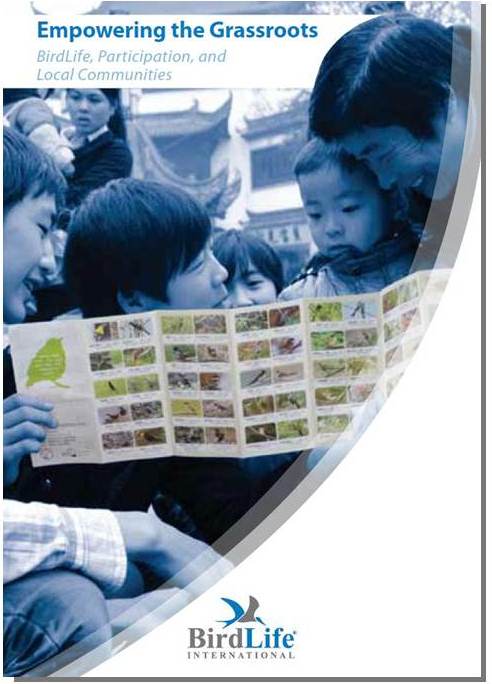
|
|
BirdLife’s structure, as a network of grassroots, national and local organisations, means that it is uniquely placed among conservation NGOs to develop and support local-level actions. BirdLife’s Local Empowerment Programmeaims to provide more effective support for local conservation actions and to strengthen and expand networks of local organisations.
A new publication entitled ‘Empowering the Grassroots – BirdLife, Participation, and Local Communities’ explains in detail the importance of empowerment to conservation and contains a wealth of case studies showcasing the diverse ways in which LCGs are benefiting both wildlife and local communities.
|
| |
To access more case studies on local empowerment, please click on the following links.
Links
BirdLife news archive: Proud moment as BirdLife Partnership in Africa launches Local Conservation Groups report
Compiled 2011
Recommended citation
BirdLife International (2011) Spotlight on local empowerment. Presented as part of the BirdLife State of the World's Birds website. Available from: https://datazone.birdlife.org/sowb/spotlocal
![]() ,
, ![]() ). Very often the place where they live is their source of food, fuel, medicine, shelter and income . Although many poor communities depend directly on natural resources, they are often forced to use these resources unsustainably in order to survive. Understanding how people experience poverty locally is essential in identifying how biodiversity conservation can help improve livelihoods (
). Very often the place where they live is their source of food, fuel, medicine, shelter and income . Although many poor communities depend directly on natural resources, they are often forced to use these resources unsustainably in order to survive. Understanding how people experience poverty locally is essential in identifying how biodiversity conservation can help improve livelihoods (![]() ).
).![]() ). Local empowerment is critical if these Important Bird Areas (IBAs) are to be safeguarded for the benefit of biodiversity and people. Consequently, BirdLife has pioneered Local Conservation Groups (LCGs; also known as Site Support Groups in Africa and Caretaker Groups in Europe) to support site-based action at IBAs. There are currently over 2000 such groups across the world. The structures, governance, membership and specific objectives of these groups vary greatly depending on the local context. This flexible approach can deliver tangible successes in a number of areas, from site conservation and monitoring to livelihood improvement and community empowerment:
). Local empowerment is critical if these Important Bird Areas (IBAs) are to be safeguarded for the benefit of biodiversity and people. Consequently, BirdLife has pioneered Local Conservation Groups (LCGs; also known as Site Support Groups in Africa and Caretaker Groups in Europe) to support site-based action at IBAs. There are currently over 2000 such groups across the world. The structures, governance, membership and specific objectives of these groups vary greatly depending on the local context. This flexible approach can deliver tangible successes in a number of areas, from site conservation and monitoring to livelihood improvement and community empowerment:
